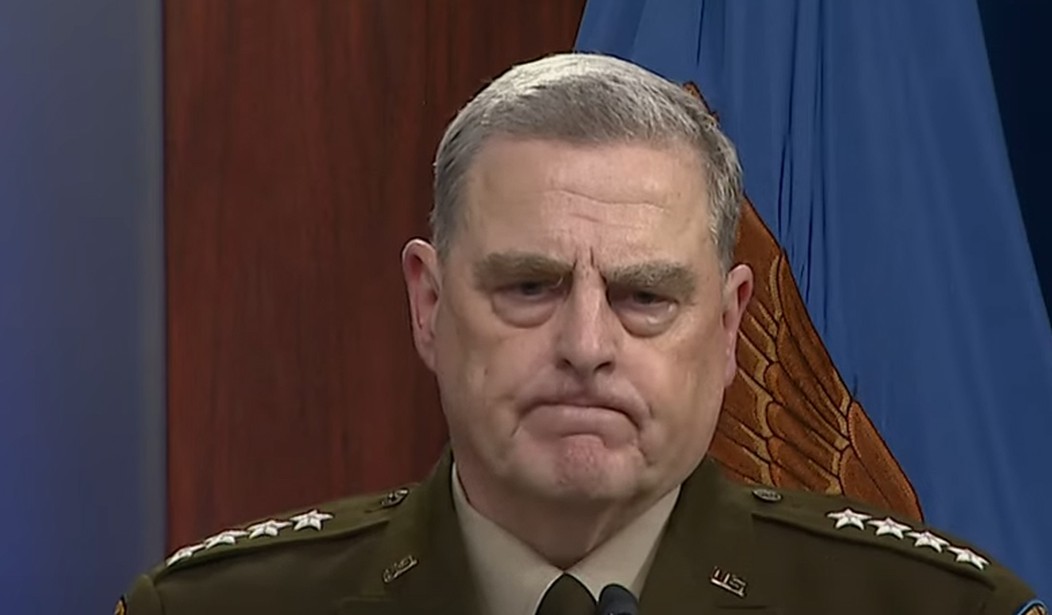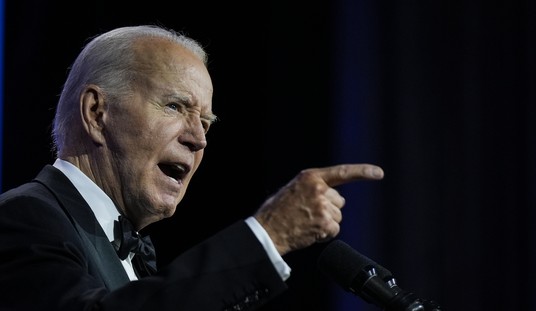During Wednesday’s briefing by Defense Secretary Lloyd Austin and Gen. Mark Milley, chairman of the Joint Chiefs of Staff, Fox national security reporter Jennifer Griffin asked the two about the decision to abandon Bagram Air Base in the weeks leading up to Afghanistan’s collapse. That decision has proven to be crucial, as it left Afghanistan with no U.S. military support and now leaves the civilians stranded there with one option: to try to get to the Kabul international airport through Taliban checkpoints. The U.S. government issued a statement saying that it cannot guarantee their safety and that even if they can get to the airport, they will face a long wait.
That wait could have been made shorter and the evacuation safer with better planning and the use of Bagram Air Base, which has two runways. HKIA only has one.
Gen. Milley took up answering the question of why Bagram was abandoned after Austin acknowledged that some U.S. military aircraft have been piloted out of Bagram by the Taliban. Milley carefully said the plan was driven by Washington, designed on the ground in Afghanistan, and then briefed all the way up the chain. Here is the entire briefing. Fast-forward to about 29:17.
“Securing Bagram is a significant level of military operating forces,” Milley says. “It would also require external support from the Afghan security forces. Our task, given to us at that time, our task was to protect the embassy,” Milley said (emphasis added).
Milley has laid out the military’s priority and where that came from: the Biden White House. The military’s job was to then determine how to carry out its task.
Relevant to all this, Sen. Mitch McConnell says Biden overrode his military commanders when he decided how to withdraw from Afghanistan.
“If we were to keep both Bagram and the embassy going, that would be a significant number of military forces…that may have exceeded what we had, or stayed the same as what we had,” Milley continued. “So you had to collapse one or the other. And the decision was made, the proposal was made, from CENTCOM commander and the commander on the ground, Scottie Miller, to go ahead and collapse Bagram. That was all briefed and approved and we estimated that the risk of going out of KIA, or the risk of going out of Bagram, were about the same, so going out of KIA was the better tactical solution…in accordance with getting the troops down to a 600, 700 number.”
Who set that number and why? It’s a rhetorical question. We know the White House set that number.
I’ve written about why the choice to abandon Bagram makes little sense, at least from the other side of the world, from a tactical point of view. Bagram is more remote, but was also much more heavily armed and offered a second runway that HKIA does not have. It offered more space to house and feed evacuees. It’s a more defensible position. Using Bagram would have necessitated military armor convoys to make the hazardous trip from Kabul outward, but HKIA is proving to be unworkable so far. It’s surrounded by the Taliban and could itself fall to them. Austin does not deny that we are depending on the Taliban not attacking and overrunning HKIA right now, as it’s full of Americans and Afghans. About 5,000 to 6,000 American troops are currently defending it — roughly double the number of troops Biden withdrew.
The decision to abandon Bagram in favor of HKIA could result in a massive, unprecedented hostage crisis, should the Taliban decide to attack and then overcome the U.S. forces defending HKIA. If that happens, the possibilities grow grimmer from there. Black Hawk Down, the Iran hostage crisis, ISIS beheadings, all possible, all by the thousands. The U.S. military will be doing very well to avoid that. The Taliban would also be wise to avoid it, as going hot would force Biden to redeploy a massive number of forces to retaliate. The possibilities spiral out of control from there.
In any case, Milley clearly says the plan to abandon Bagram came from the commander in Afghanistan, Gen. Austin “Scottie” Miller, in response to orders from Washington.
It’s tempting to call for Miller’s firing now, but there’s a problem with that. He already left.
NBC ran this story about Miller stepping down from command of U.S.-NATO forces on July 12. It’s poignant now to read the quotes he and his commander, CENTCOM’s Gen. Frank McKenzie, offered Afghanistan at the time of Miller’s departure.
In a transfer of authority ceremony at Resolute Support Headquarters in Kabul Monday afternoon, Army Gen. Austin “Scott” Miller said, “The people of Afghanistan will be in my heart and on my mind for the rest of my life.” He called the post “the highlight of my military career.”
“Our job now is not to forget” those who sacrificed here, he said.
And:
McKenzie told Afghan forces, “You can count on our support in the dangerous and difficult days ahead.”
Clearly, they could not count on that support. McKenzie knew so at the time. Miller’s plan would have been in development and briefings since April at the time of his departure on July 12.
In fact, the United States abandoned Bagram Air Base a full week prior, the AP reported at the time. Miller’s plan had already been initiated on July 5.
BAGRAM, Afghanistan (AP) — The U.S. left Afghanistan’s Bagram Airfield after nearly 20 years by shutting off the electricity and slipping away in the night without notifying the base’s new Afghan commander, who discovered the Americans’ departure more than two hours after they left, Afghan military officials said.
Before that, Miller obliquely warned that disaster could be on the way. On June 29, as the Taliban made rapid gains, Miller spoke to media:
Miller told a small group of reporters in the Afghan capital that for now he has the weapons and the capability to aid Afghanistan’s National Defense and Security Forces.
“What I don’t want to do is speculate what that (support) looks like in the future,” he said.
A few days later, he initiated his plan and abandoned Bagram Air Base. And then he left Afghanistan.
Bagram is huge and could have been used to stage at least part of the non-combat evacuation operation (“NEO” in military-speak) that’s now underway. Milley says this is the second-largest NEO in U.S. history. Saigon, which Biden said would not happen, is probably the larger one Milley refers to.
The military left numerous vehicles behind at Bagram but left no serious ammunition for the Afghan military.
The big ticket items left behind include thousands of civilian vehicles, many of them without keys to start them, and hundreds of armored vehicles. Kohistani said the U.S. also left behind small weapons and the ammunition for them, but the departing troops took heavy weapons with them. Ammunition for weapons not being left behind for the Afghan military was blown up before they left.
This was the plan: bug out of the largest U.S. base in the dead of night without even telling our allies, then a week later reassure them that we were always going to stand by them—when the military knew Biden had no intention of doing so.
Leaving in the dead of night without even notifying anyone was perhaps narrowly justifiable from an operations security point of view but it was a strange way to show support for an ally. It showed no regard for how, culturally and psychologically, they might react. It appears to have left the Afghan forces feeling betrayed and abandoned. Add to this, Biden’s decision to blind them by withdrawing intelligence support and grounding them by denying them aircraft maintenance contractors. The Pentagon should have anticipated a quick collapse and planned for that based on the impossible conditions Biden set, but Milley says that the military and the U.S. intelligence community did not. The intelligence community seems to believe otherwise.
This is a clear and obvious failure, a shocking failure, that should rattle all of our allies.
The architect of that plan, Gen. Scott Miller, already had his ramp out of the military paved as it was being executed. The timing is interesting.
I’m not scapegoating Miller. Yes, if he was still the commander in Afghanistan he should have resigned and I would be calling for him to do so. Perhaps his decision to step down when he did was an acknowledgment that he had been set up to fail along with all of the U.S. and allied military in Afghanistan, and he did not want to be around and be left holding the bag, but also did not want to want a spectacle in the press. Milley himself hints at some of this but lacks the courage to come right out and say it: The military commanders were given an impossible mission and were forced to make an impossible choice by an inept commander-in-chief. “Our task, given to us at that time, our task was to protect the embassy,” he said.
They still, in my estimation, managed to make everything even worse by choosing to defend the wrong patch of ground. They had a choice and chose very poorly. That’s not hindsight, it’s a recognition of how things are playing out right now. Again, Bagram provided capabilities that HKIA does not.
But the choice was forced on them by a man in the White House who never served in uniform, who foisted his drug-addict son on the military, and who set arbitrary dates for withdrawal without any regard for the conditions and facts on the ground. Biden’s MO since taking office has been to fling executive orders and edicts with no regard for the real-world consequences, and then blame Trump or someone else when it blows up in his face.
Joe Biden deserves all the scorn that is being heaped on him now, all of it and more. So do all of his commanders. They could have and could now tell the American people the unvarnished truth. They could stand up for the honor of our country. They could be the adults in the room we need. Instead, they are talking around the heart of the issue and defending the indefensible.
On June 29, a few days before abandoning Bagram and two weeks before he departed Afghanistan, Gen. Miller said, “The future will tell the rest of the story. What we will have to do is make an honest assessment of what went well and what didn’t go so well over the years as we work forward.”
Will that honest assessment ever come? It would have to start with the man in the White House, what he did, when, and why.









Join the conversation as a VIP Member